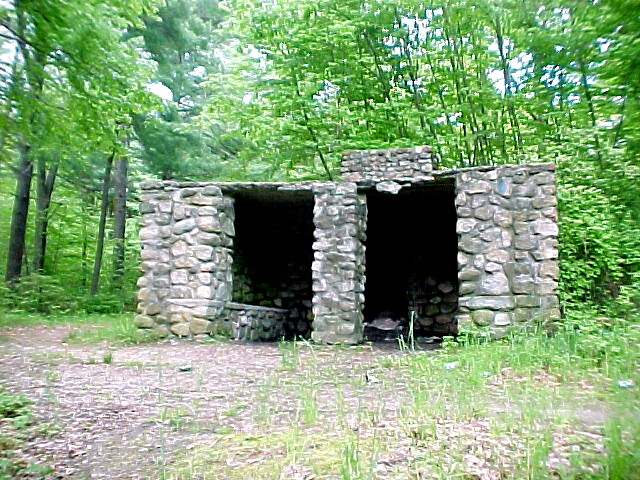
[Warren Henry] Manning's earliest involvement with developing Hopedale's park system coincided with his eight year tenure in the firm of Frederick Law Olmstead. However, the plan was not finalized and work not begun on The Parklands, 162 Dutcher Street, until 1898, by which point Manning had established his own practice. In 1899, the town's Park Commission, consisting of Frank J. Dutcher, Charles F. Roper, and George Otis Draper, accepted Manning's proposal for a park of nearly two hundred acres, encompassing the entire shoreline of Hopedale Pond, known at the time as the Upper Privilege. The Hopedale project provided Manning with "the opportunity on a small scale to do what Olmstead and Eliot did in Boston with the Muddy River development, which emerged as the nation's first regional park system in 1892." [Garner, 194] The town appropriated $14,000 initially for the park project and $2,500 annually thereafter, implementing each year until 1914 a Manning-designed addition or improvement. A park superintendent directed the planting work and maintenance year-round. Even in the winter, the woods were continually thinned out and brush was burnt. The work crew burgeoned to thirty or forty men during spring planting season. [Alvord, 61-62; Garner, 192-195]
The principal objective of the design and execution of the Parklands was to keep the pond and the park "as natural as possible, to refuse any touch of artificiality, except in that portion where closeness to the houses forces certain yieldings to a cultivated aspect." [Alvord, 61] As described by Garner, landscaping entailed combining several properties, surveying and planning, and ground reclamation through draining, filling, and replanting. [Garner, 194] One of the first improvements was the creation, in 1899, of a bathing beach at the southern end of the park, near the intersection of Hopedale, Dutcher, and Northrop Streets. Sand dumped on the ice in the pond during the winter [1899] settled to form the beach. [Alvord, 61] The bathhouse, designed by Chapman and Frazer, was added in 1904. Near the northeastern side of the pond, a nursery was established within the boundaries of the park for the purpose of cultivating seedlings, and transplanting from the nursery took place during a period of at least three weeks each spring. Maple, ash birch, hickory, and pine seedlings were native to the park. Tree species that were introduced included hemlock, tulip, mountain ash, Carolina poplar, black alder, striped maple, willows, Japanese barberry, red-osier dogwood, bittersweet, and cedars. A period account described the 'three rules for planting: the trees must look as though they came there by accident, the bare places must be gradually covered, [and] picturesque trees must be set on the border of the water." [Alvord, 62] A ribbon of trails designed in 1907 wound around the irregular shoreline for more than a mile in length; by 1914, this path system of "natural-looking walks," which survives today, extended for more than four miles. Hunting was prohibited in the park, and 125 birdhouses were raised. Three stone shelters were constructed; one on an island in the pond, one on the far western edge of The Parklands, high above the pond, and one between the pond and The Driftway. [Garner, 195; Alvord, 62ff; Elaine Malloy interview]
The view south from the shore of Hopedale Pond to the Draper plant on Freedom Street provides a striking image of large-scale industry framed by a natural, albeit designed, landscape. A period account offers the highest compliment of the park's planning and execution, as well as, indirectly, a tribute to the vision of the Drapers: To-day Hopedale possesses, in place of an ugly mill-pond, disfigured with dead trees and unsightly dump-heaps, a park whose path plunges from her very thresholds right into cool, deep woods, whose lake surface is fit for fishing, boating, swimming, and skating in the winter, whose brooks are crossed with artistic bridges, whose gorgeous and varied forest looks as though it originated there, and whose winding paths seem the offspring of chance and idle wanderings [Alvord, 82]
Alvord, James C. "What the neighbors did in Hopedale." Country Life in America, 24 (January 1914) pp. 61, 62, 80-82.
Garner, John. The Model Company Town: Urban Design Through Private Enterprise in Nineteenth-Century New England. Amherst: The University of Massachusetts Press, 1984.
Malloy, Elaine, Director of the Bancroft Memorial Library, Hopedale. Interview with K.K. Broomer, June 2001.
This history of The Parklands was taken from the National Register Nomination written by K. K. Broomer
The following paragraph is also in the National Register Nomination:
On the northwest is The Parklands which covers the area surrounding Hopedale Pond, extending roughly from the Grafton & Upton Railroad right-of-way to the rear property lines of houses on Dutcher Street. Landscape architect Manning designed the park, which encompasses approximately 273 acres, about thirty-six of which constitute the pond and islands. The park includes a bathing beach (1899) and bathhouse (1904) near Hopedale Street. The Craftsman-style bathhouse in one story on a T-shaped plan, about five bays by two bays, with wood shingle siding and an asphalt shingle cross-gable roof. The building has overhanging eaves, exposed rafters, decorative bargeboards, and irregular fenestration with six-pane sash. On the pond side of the building are three doors, only one of which is currently operable. An intact trail system (designed 1907) leads to scenic views and rock outcroppings and has outlets to Hopedale, Dutcher, Freedom, and Hazel Streets. Within the mowed area immediately north of the bathing beach are two additions to the landscape: a one-story, hip-roofed garage facing Dutcher Street to the east, and, in a clearing overlooking the pond, a 1996 monument for the Hopedale Parklands Nature Trail, dedicated to Willard W. Taft. The monument is a granite boulder with an attached brass plaque.
A Walk Through the Parklands Excerpts from the Reports of the Park Commissioners, 1899 - 1905 Park, Pond, Sports Menu The Second Fireplace Fishermen's Island The Lookout HOME



